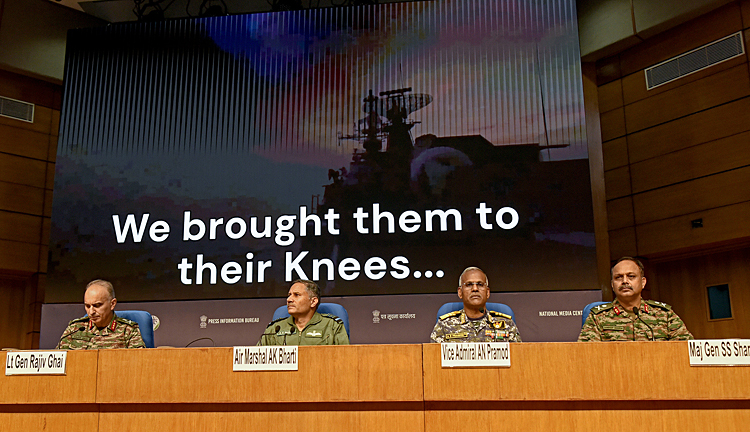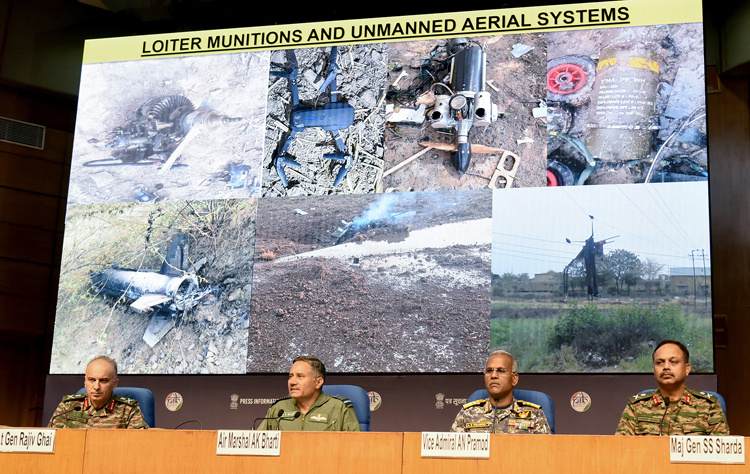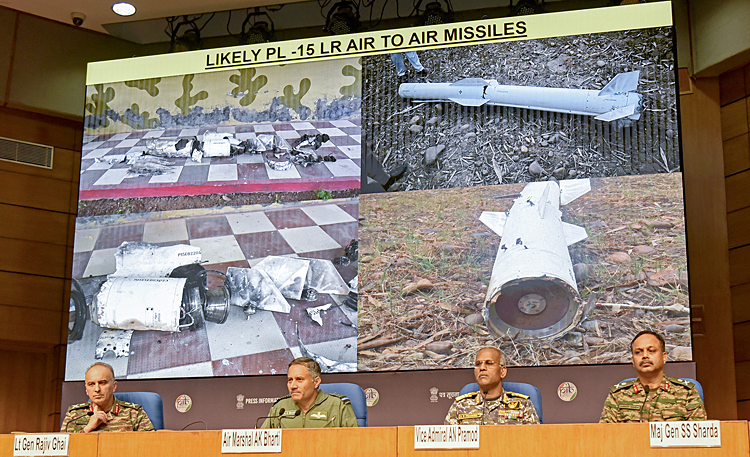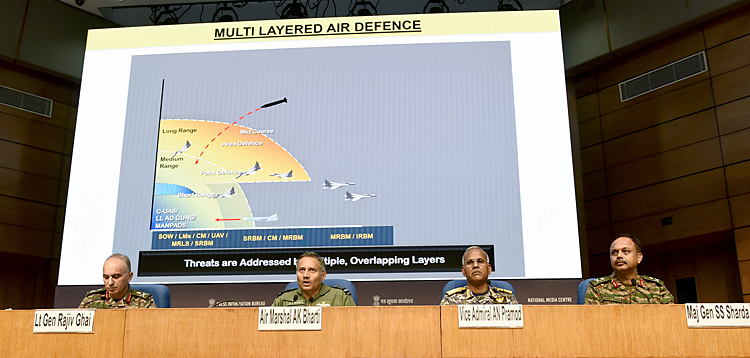INDIAN ARMED FORCES CHIEFS ON OUR RELENTLESS AND FOCUSED PUBLISHING EFFORTS

The insightful articles, inspiring narrations and analytical perspectives presented by the Editorial Team, establish an alluring connect with the reader. My compliments and best wishes to SP Guide Publications.

"Over the past 60 years, the growth of SP Guide Publications has mirrored the rising stature of Indian Navy. Its well-researched and informative magazines on Defence and Aerospace sector have served to shape an educated opinion of our military personnel, policy makers and the public alike. I wish SP's Publication team continued success, fair winds and following seas in all future endeavour!"

Since, its inception in 1964, SP Guide Publications has consistently demonstrated commitment to high-quality journalism in the aerospace and defence sectors, earning a well-deserved reputation as Asia's largest media house in this domain. I wish SP Guide Publications continued success in its pursuit of excellence.
Operation Sindoor | Day 2 DGMOs Briefing
Armed Forces Showcase Deterrence, Air Defence Capabilities and Maritime Supremacy

The second day of the high-level tri-services press briefing on Operation Sindoor began not with military jargon, but with poetry vocals in the backdrop —an evocative reminder of India's civilisational ethos and the tragedy of conflict. The solemn tones of Mahakavi Ramdhari Singh Dinkar's Rashmirathi echoed across the media hall:
"जब नाश मनुज पर छाता है,
पहले विवेक मर जाता है।…"
"When destruction looms over mankind, the first casualty is discernment, or wisdom"
With these lines, the Indian Armed Forces framed the backdrop to the events of the past week—a campaign of precision and restraint launched not in aggression, but in defence of sovereignty and security.

In continuation of the detailed revelations from May 11, today's briefing focused on India's defence preparedness and response matrix—emphasising counter-drone operations, air defence performance, and maritime dominance during the recent escalation.
Integrated Air Defence & UAV Neutralisation
Air Marshal A.K. Bharti, Director General of Air Operations, provided a comprehensive update on the neutralisation of over a dozen UAVs and UCAVs launched by Pakistan in the aftermath of Operation Sindoor. Many of these, he noted, were equipped with advanced Chinese-origin systems like the PL-15 air-to-air missile and Turkish Songar and Byker YIHA kamikaze drones. "Each was detected, tracked, and destroyed using a blend of battle-tested platforms and next-generation indigenous systems," he said.
"Our Integrated Air Command and Control System (IACCS) ensured a seamless, net-centric defence across domains."
He credited India's indigenously developed Akash missile systems, counter-UAV technologies, and legacy platforms like Pechora, a medium-range surface-to-air missile (SAM) system and ZSU-23-4 Shilka, a self-propelled anti-aircraft gun for their critical role in defending key installations and civilian areas. "Our Integrated Air Command and Control System (IACCS) ensured a seamless, net-centric defence across domains."
Striking visuals displayed on screen showed wreckage of downed UAVs, drone propellers, and missile debris along with a deep evidence of what the Air Marshal called "razor-sharp vigilance and zero compromise."
Weapon systems used by Pakistan were bought down by the Air Defence Systems. Our offensive actions targeted the length and breadth of the adversary.

Weapon systems used by Pakistan were bought down by the Air Defence Systems. Our offensive actions targeted the length and breadth of the adversary.
Precision Strikes & Air Superiority
The Air Force presented follow-up images from previous strikes on terror launchpads in Bhawalpur, Muridke, and the Rahim Yar Khan airbase. "Our targeting was precise, our objectives clear. We struck where it hurt—terror camps and not civilian infrastructure," the officer reiterated. The screen came alive with a massive crater caused on the runway of the airbase.
Maritime Deterrence & Area Denial
Vice Admiral A.N. Pramod, DG Naval Operations, described how India's Carrier Strike Groups had ensured complete maritime dominance in the Arabian Sea during the operation. "We deployed a layered fleet air defence mechanism supported by MiG-29K fighters, AEW helicopters, and long-range sensors. Not a single hostile aircraft came close to our battle group."
India's Carrier Strike Groups had ensured complete maritime dominance in the Arabian Sea during the operation
Naval surveillance and electronic warfare systems worked in sync to enforce an extended denial bubble, forcing adversary air assets to remain bottled up near their own coasts. "Any attempt to threaten our presence at sea was swiftly countered."
Army's Role & Civilian Safeguarding
Lt General Rajiv Ghai, DGMO Army, reaffirmed India's commitment to protecting civilian lives while maintaining operational superiority.

"We responded only when provoked—our restraint must not be mistaken for weakness," he said, referencing Pakistan's drone and artillery provocations after the initial strikes. He noted the changing character of terrorist targeting, often aimed at unsuspecting civilians. War in recent times has unfolded without crossing borders, and India was prepared with a multilayer counter-drone and air defence grid. "Our AS weapons, ISR support, and multi-tiered systems ensured rapid interception."
War in recent times has unfolded without crossing borders, and India was prepared with a multilayer counter-drone and air defence grid
To illustrate the efficiency of this layered defence, Lt General Ghai invoked a sharp sporting analogy:
"Ashes to ashes, dust to dust, if Thommo don't get ya, Lillee must."

"If you see the layers, you'll understand what I am trying to say. Even if you cross all the layers, one of them will get you." India's ground forces, backed by real-time intelligence, surveillance, and reconnaissance assets, have maintained a strong defensive posture since the ceasefire lines were breached.
Diplomacy & Deterrence
The DGMO-level dialogue between India and Pakistan has resulted in the restoration of the 2021 ceasefire agreement. While India remains open to peace, officials made it clear that provocations would not go unanswered. "Let there be no doubt—peace is our preference, but deterrence is our doctrine."
India's ground forces, backed by real-time intelligence, surveillance, and reconnaissance assets, have maintained a strong defensive posture since the ceasefire lines were breached.
As the briefing concluded, Director General of Air Operations echoed a timeless truth drawn from Indian philosophy:
"भय बिन होय न प्रीत" - "There is no love without fear."
In the realm of power and deterrence, respect must be earned!





